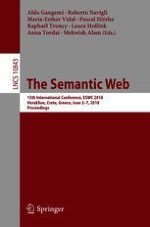2018 | Buch
The Semantic Web
15th International Conference, ESWC 2018, Heraklion, Crete, Greece, June 3–7, 2018, Proceedings
herausgegeben von: Dr. Aldo Gangemi, Prof. Roberto Navigli, Maria-Esther Vidal, Prof. Dr. Pascal Hitzler, Raphaël Troncy, Laura Hollink, Anna Tordai, Mehwish Alam
Verlag: Springer International Publishing
Buchreihe : Lecture Notes in Computer Science
